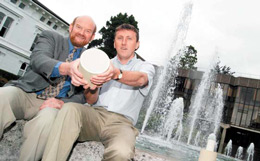| 2005 |

|
YEAR BOOK |
University of Limerick � Materials Ireland
|
Corrosion resistance of ceramic diesel
particulate filters
|


With time, DPFs become loaded with PM and, to avoid unacceptable back pressure in the engine, regeneration through incineration of the carbon soot is necessary. Although the incineration temperature is nominally 550-650�C, the use of catalytic fuel additives such as ferrocene ((C 5 H 5 )2Fe) or cerium carboxylate (Ce(COOH) 4 ) can reduce the ignition temperature by 250�C. These additives introduce solid iron and cerium species in the exhaust stream, which along with the inorganic components of PM, are deposited on the walls of the filter. During regeneration the inorganic contaminants are oxidised and the oxides remain on the filter as an ash.
The carbon burn-off reaction is highly exothermic and, if uncontrolled, which may occur during prolonged idling of the engine, can cause local temperature peaks over 1000�C. At such temperatures the ash may react with the ceramic structure causing premature failure. As a result concern has been expressed regarding the chemical durability of DPFs in the presence of ash as a function of temperature and time.
Essential properties of DPF materials are low coefficient of thermal expansion, high thermal shock resistance and thermal stability. Cordierite (Mg 2 Al 4 Si 5 O 18 ) is one material that meets these criteria. Coupled with its low cost and ease of component manufacture, cordierite has become the preferred material in many heavy duty vehicle applications. In recent years, silicon carbide (SiC) has been successfully used in DPF applications for light duty vehicles because of its good thermal conductivity, refractoriness, and chemical durability.
Corning Incorporated, a world leader in the production of ceramic honeycomb structures for automotive applications, and the Materials Ireland Research Centre (MIRC) at the University of Limerick have been collaborating for several years in a series of studies on the chemical durability of a number of DPF substrate materials, including cordierite and SiC, to corrosion by ash formed from the combustion products of diesel fuel containing iron or cerium based fuel additive.
In order to monitor the reactions between individual ash components in the presence of carbon and between the ashes and the substrate materials, three ash compositions were prepared. These compositions corresponded to ashes predicted to form on a DPF as a result of the combustion of diesel fuel containing no fuel additive, diesel fuel containing the iron based fuel additive and diesel fuel containing the cerium based fuel additive. Powder compacts of the ashes and the substrate-ash systems were prepared by pressing milled mixtures of crushed DPF, carbon, oxides of iron, cerium, calcium, phosphorous and zinc and sulphates of iron and zinc. The substrate to ash ratio corresponded to an in-service filter lifetime of 160,000 km. The carbon content of the ashes corresponded to the predicted soot present on a DPF if one regeneration cycle was missed.
Reaction temperatures were identified using thermal analysis (TGA�DTA). Compacts of the mixed oxide compositions were prepared and heat treated at the identified reaction temperatures. Heat treated powder compacts were then analysed by X-ray diffraction (XRD) to identify reaction products, and Scanning Electron Microscopy (SEM) to observe particular reaction products or areas of corrosion.
Furthermore, to simulate the effect of an ash deposit on the filter surface, cordierite and SiC filter samples were sprayed with salt solutions to obtain surface coatings with the three predicted ash compositions. These samples were then heat treated at the same temperatures used for the powder compact samples and analysed in the same way.
In the case of silicon carbide, little oxidative or chemical degradation was observed in the presence of any of the ashes below 1000�C and for the cerium based ash this temperature limit may extend to 1100�C. Accelerated oxidation is induced by Ca, Zn, and P. The only significant degradation mechanism which might be experienced by silicon carbide DPF systems at elevated temperatures, is pore blockage due to the ash agglomerating and sintering in gas transfer pores, if neither Fe nor Ce is present in the ash.
The behaviour of cordierite is similar in that no catastrophic degradation effects occur at temperatures of 1100�C and below. There is however, evidence to show that cordierite undergoes reaction with some lubricant constituents which may cause chemical degradation.
The results of the studies showed the suitability of using cordierite or silicon carbide as DPF substrates in the presence of iron or cerium based fuel additives. However, it is important that careful control of the temperatures experienced by the filter is exercised, with temperatures in excess of 1100�C to be avoided.
Contact: Dr. David O'Sullivan, Materials Ireland,
University of Limerick, Limerick;
Tel: 061 202357, Fax: 061 202967;
E-mail: [email protected]; Web: www.mirc.ul.ie